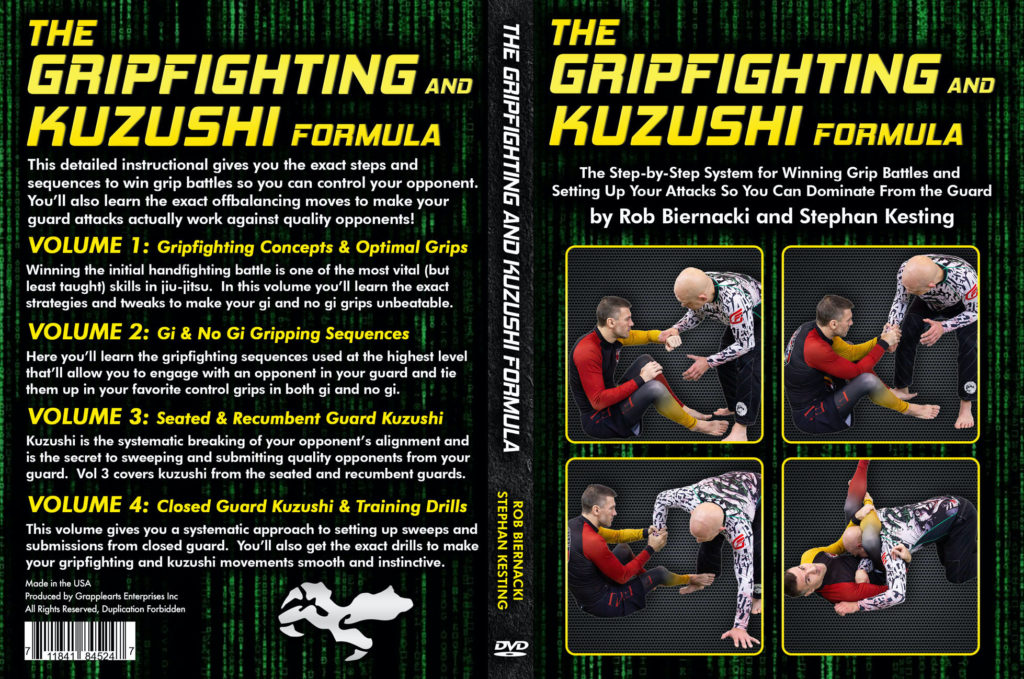Let’s talk about Kuzushi in BJJ, and why it’s a critical skill to develop if you want to have good guard sweeps, submissions and backclimbs.
When you learn a technique from the guard like a new sweep it usually works great at first. You’ll be sweeping your training partners all over the place with your shiny new toy.
But then your training partners stop making whatever mistake they were making that allowed that attack to work. They figure out how to shut down the openings you need and then – poof – the sweep stops working.
At this point do you go and learn a new technique?
NO! Just learn how to set up your attack better!!
This art of setting up your attacks, offbalancing your opponent, and breaking his alignment is called ‘Kuzushi’.
Kuzushi in Judo
The term Kuzushi (崩し:くずし) comes from Judo, and it’s an absolutely critical part of doing those spectacular throws. Before you can hoist some dude over your head you have to offbalance him enough to get underneath him, right?
As a result Judo practitioners will spend a HUGE amount of time working on their Kuzushi. They’ll drill the movements repetitively in isolation, while moving across the mat, with rubber bands attached to their training partners for added resistance, and in sparring.
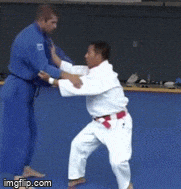
No Kuzushi, no Judo throws!
Kuzushi in BJJ
So Kuzushi is critical for Judo, but it’s equally important for BJJ, especially when you’re attacking from the bottom!
In fact it’s the secret sauce that separates recreational jiu-jitsu students from world class guard players. Basically kuzushi is required to sweep or submit people who don’t suck.
Just launching ‘a technique’ at your opponent from the guard might work against a beginner. That’s because beginners break their own alignment all the time and don’t know the counters to your moves.
But once you start going against better people in BJJ you’ll quickly find that they instinctively stay in good alignment most of the time. People will also figure out counters to your moves. That’s why you have to get super-serious about destroying their base, posture, and structure before you attack.
Once your opponent’s alignment is compromised he’s much less able to prevent the sweep or submission. Kuzushi breaks his alignment and kills the counters. And against a clumsy or inexperienced opponent the Kuzushi motion can even knock him to the ground and serve as an ersatz sweep!
Here’s a short video I put onto Youtube which breaks down Kuzushi in a BJJ context for you in 61 seconds…
The takehome message is that every single sweep, submission, or backclimb attempt should be preceded by off balancing your opponent first.
The 3 Basic Types of Kuzushi
You can disrupt your opponent’s balance from guard in both gi and not gi, and in every form of guard including the closed guard, recumbent open guard, seated guard, half guard, etc.
There are three basic types of Kuzushi from the guard. Here’s a quick video breaking them down…
1, Hanging or Swinging Kuzushi
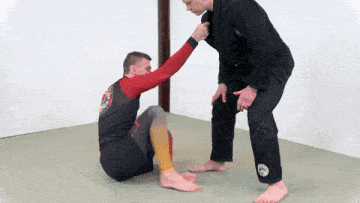
Hanging or Swinging Kuzush
In this style of Kuzushi you’re using your bodyweight to pull your opponent forward and break his balance.
There are many variations of this approach. For example, in the example above Rob is using a lapel grip to attach his weight to my body and a collar drag motion, but the exact same approach could be applied using a collar tie, a wrist grip, a belt grip, or a behind-the-knee grip.
This category of Kuzushi is very versatile and can be used against standing, squatting and kneeling opponents in both gi and no gi.
2, Blocking and Pushing Kuzushi
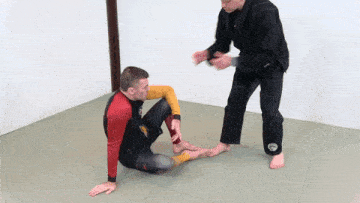
Blocking and Pushing Kuzushi
In the ‘blocking and pushing’ category of Kuzushi you impede your opponent’s ability to move in a certain direction and then push him towards that direction.
The idiot sweep shown above is a classic example of the blocking and pushing style of Kuzushi: Rob hooks his insteps behind my ankles and then pushes my legs with his hands: this disrupts my balance backwards. The tripod and tomahawk sweeps are other classic examples of this kind of attack.
3, Intercepting Kuzushi
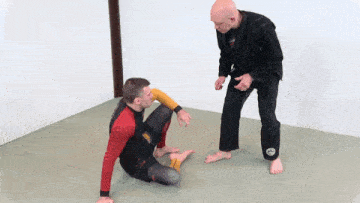
Intercepting Kuzushi
The intercepting style of Kuzushi is based on timing and doesn’t require much strength.
Much like certain Judo foot sweeps you use this when your opponent’s foot is off the floor and intercept it, accelerating it in the direction it was already moving. This is a very disorienting feeling for the person on the receiving end and can leave him completely out of base and facing the wrong way.
Intercepting Kuzushi works in both gi and no gi, but is mainly applied against standing opponents.
The 4 Functions of Kuzushi
To finish this article let’s briefly look at some of the different functions and benefits of using Kuzushi from the guard in jiu-jitsu….
1, Kuzushi as a Sweep
A correctly applied Kuzushi movement can be a guard sweep in it’s own right and take your opponent all the way down to the mat. This is more common if your opponent is clumsy, not paying attention, or not familiar with the offbalancing technique you are using.
Athletic or experienced opponents will usually be able to block the sweep and/or scramble out of it, but in doing so they open themselves to your followup movements which should be pre-programmed and waiting for them!
2, Kuzushi for Sweeps and Submissions
A good opponents might not fall over when you use your Kuzushi movement on him, but he will have to react.
This reaction is what allows you to set up your sweeps and submissions.
Maybe he’ll be forced to take expose his leg, and allow you to Imanari roll into a heel hook. Maybe he’ll be forced to post a hand opening up the triangle choke. Or maybe he’ll allow you to get under his center of gravity and sweep him.
Here are some concrete examples… In this de la Riva sweep BJJ black belt Jon Thomas offbalances his opponent forward before sweeping him backwards. And in one of my favorite butterfly guard attacks I hang my weight off my opponent while blocking his leg to set up a triangle choke.
3, Kuzushi to Transition to Other Positions
A skilled opponent is never just going to let you get your favorite guard position. He’s not going to let you slide under him and get into a type of X guard. He’s not going to just give you the grips you need to knock him all over the place in spider guard. Hell, he’s not even going to let you close your legs around him and achieve closed guard!
The fact is that you need to set up your more dominant guard positions just like you need to set up your submissions.
If your favorite guard is the deep half guard then learn the Kuzushi you need so you can repeatedly get there on your own terms rather than relying on your opponent to make a mistake and give it to you!
4, Kuzushi to Push the Pace and Keep You Safe
Kuzushi movements are typically small movements that don’t require a ton of energy on your part. But that’s not true for your opponent; it takes a LOT of energy to recover his position all the time which helps push the pace and tire him out.
Once he’s off-balance and his alignment broken he won’t be trying to pass your guard; he’ll be so off balance that all he’ll be thinking about is recovering his position. He’s the one reacting, scrambling back into position, and burning energy.
All of this is good for you and bad for him.
Kuzushi should be used continually in gi and no gi, against both standing and kneeling opponents, and from both the closed and open guard. It’ll give you a great big unfair advantage.
There’s no such thing as magic in BJJ, but properly applied Kuzushi comes pretty close.
Cheers,
Stephan
P.S. This topic is so important that I have published an instructional which covers it in great detail (along with gripfighting which is another cheat code for the guard).
I did this instructional together with renowned BJJ black belt Rob Biernacki, and it covers the concepts, strategies, techniques and training methods for winning the initial guard battle and settinng up your sweeps, submissions and back takes.
It’s really good, which is why it’s 100% covered by my 365 day moneyback guarantee.
Click here for more information about The Gripfighting and Kuzushi Formula.
The post What is Kuzushi in BJJ and What Can It Do For You? appeared first on Grapplearts.

